Dear Bread Fans,
In the last week, two people have dreamt of me and bread. I like knowing that my daytime preoccupations are traveling through the ether. In Ellie’s dream I was researching bread history, and in Linda’s dream I was baking bread.
In reality, I was down in Miami, dazed by the heat and humidity, and surprised by the building and plantscape so different from what I know. Palm and banyan trees, live oaks, ferns growing on branches, tiny lizards skittering back to the edges of unfamiliar-to-me shrubs. I can only understand the flora and fauna, the house and road patterns of the Northeast, where I’m from. I lived in Seattle for the 90s, and I hardly believed in the drippy rain and monkey-puzzle trees. Were the Olympic Mountains and Rainier a mirage? Life there always felt surreal, and I’m still struck by my animal need for the known – I step out like a little lizard and skitter back to the shade of my shrubs!
This time, I was brought away from my familiars by Simmering Minds, the brainchild of Sara Martinez and Catherine van den Bossche-Duque, who are creating culinary events and education. Catherine ran a bakery here for five years, Madame Lecker, and in the leadup to opening, she was starved for education. This hunger was part of why she and Sara brought Jordi Morera, a fifth-generation baker from Barcelona, to teach two, two-day master classes about bread.
Jordi is, as my father would say when a person impressed him, a wonder. He has great energy and knowledge and a hunger for sharing. His family bakery started 135 years ago. His interests are broad, stretching far beyond the bread conventions that evolved with the bakery. He explores natural leavening and whole grain flours; he grows wheat to get to know the work and challenges of farming, and mills too. He has written two books. I watched him teach for an hour and wished I could understand Spanish!
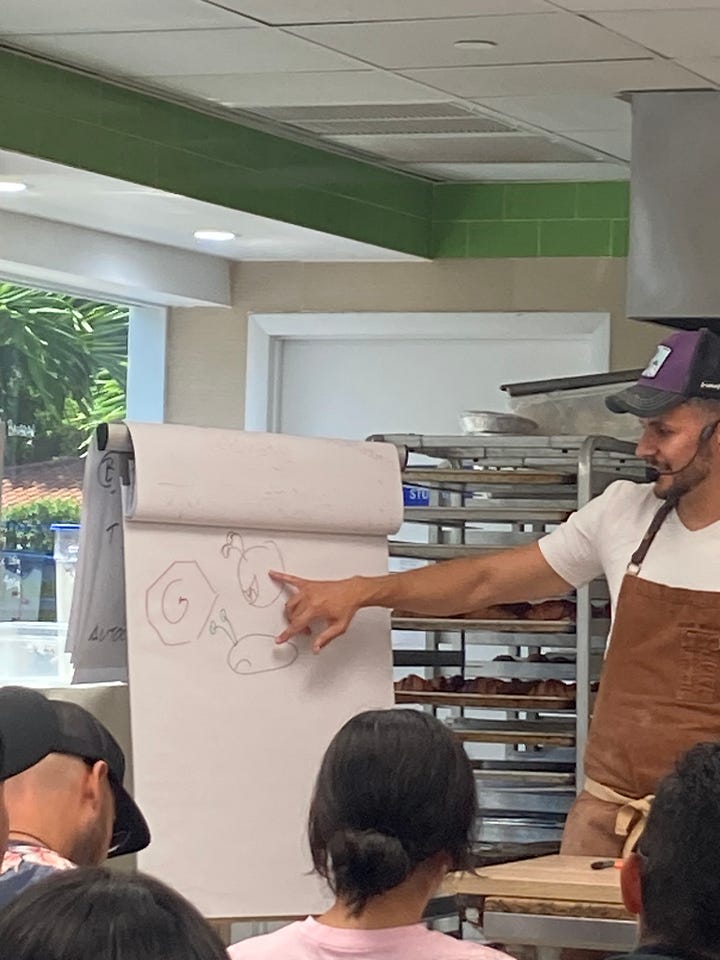

On Thursday night, I was part of a conversation, Let's Talk About Bread. First, Jordi gave a dynamic talk, complete with a crash course on of the evolution of wheat, and Sara offered a condensed translation of his Spanish. “Bakers transform materials from the earth and the sun,” he said. “Plants feed the ground as they feed themselves and bakers have the challenge of transforming flour in 24 hours – far more quickly than cheesemakers or wine makers!” Bakers step into the process and transform starch into sugars, and have an opportunity to facilitate changes in farming, too. What if, he said, bakers chose to use 25% regeneratively grown flour? And focus on wheats that have lower protein contents, which tend to have less inputs applied in the farming process. We know that natural leavening and whole grains are better for our bodies, Jordi said, but as bakers we can influence more than health. We can make a choice that positively impacts the environment.
His talk set the stage for a discussion of how changes in milling and baking are happening – and not happening – in America and in Spain. The panel included Richard Bourdon, who tuned in remotely from Berkshire Mountain Bakery in Housatonic, MA. Millers Jennifer Lapidus from Carolina Ground, and Harold Wilken from Janie’s Mill were here in person. Richard Bourdon has been baking bread for 40+ years, and you may know him from Michael Pollan’s series, Cooked. He’s a significant mentor of the first generation of American bakers to choose natural leavening, including Jen, who was a baker (of Desem bread, a Flemish style of natural leavening that uses freshly milled flour, and wood-fired ovens) for 14 years before she started Carolina Ground. Harold is a fourth-generation farmer in Illinois who switched to organic 20 years ago and opened Janie’s Mill in 2017. I asked questions about their experiences to show how bakers, farmers and millers are collaborating and helping make broader changes to the way grains are grown and flour is used. And I tried to explain how vast the existing flour system is, and why creating alternatives to it is a challenge.
Understanding the scale of industrial grain farming and milling is tough, like trying to grasp the size of a galaxy. In America, corn and soy dominate conventional agriculture, and half our wheat goes for export. Growing food grade grains outside of the grain belts has been uncommon for at least a century, so regional milling infrastructure vanished then, too. There’s only a handful of alternatives, some of them historic operations, a few from the back-to-the-land movement of the 1970s, and many as part of the locavore movement of the last 10-15 years.
NOTE: Our conversation did not include the colonialism at the root of wheat in North America, a topic thoughtfully covered by Luke Churchill this week at Vittles, in The Hidden Legacies of Canadian Strong White Bread Flour. Please read this story, and a companion piece about Weetabix cereal.
Our talk in Miami focused on changing the existing food and farming systems to be healthier for individuals, and more environmentally friendly – all through the vehicle of delicious bread and flavor-forward flours. Through bread, we can drive change all the way back to the field – as eaters by asking for/making bread made with natural leavening, and by baking with/buying bread made from more ecologically grown grains. The crowd at the talk and the students in classes included professional bakers and the serious, curious folks bread events like this gather. Jordi’s call for bakeries to foster change by using a percentage of flour – whole grain, regeneratively/organically grown, off the standard grid – met a good audience.
Two bakers joined us to show how these ideas are taking place in Miami, Helen Kim from Oori Bakeshop and Emil Hristov from Domaselo. Both brought beautiful examples of good flour and natural leavening in action and so did Jordi – what a delight!
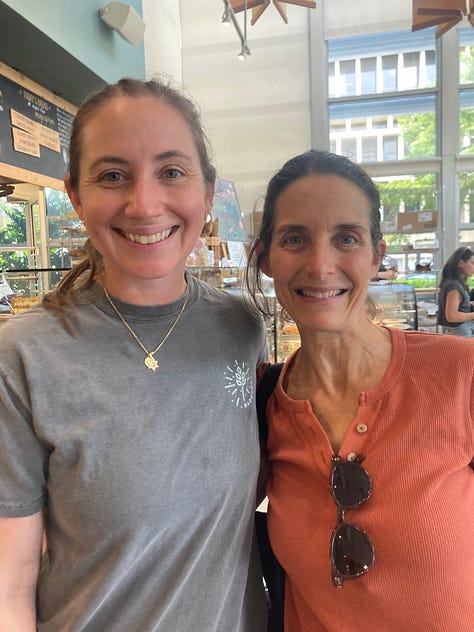
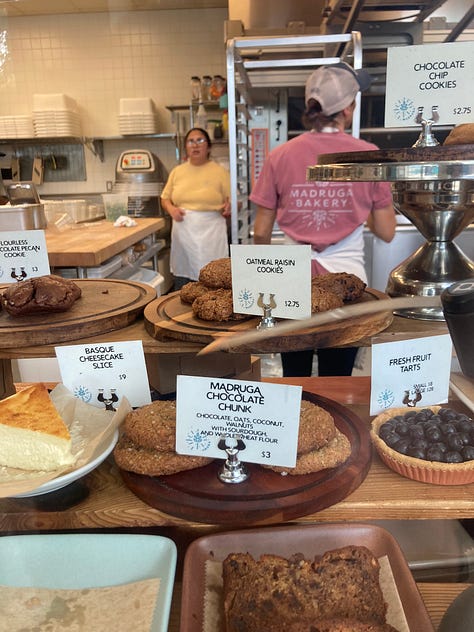
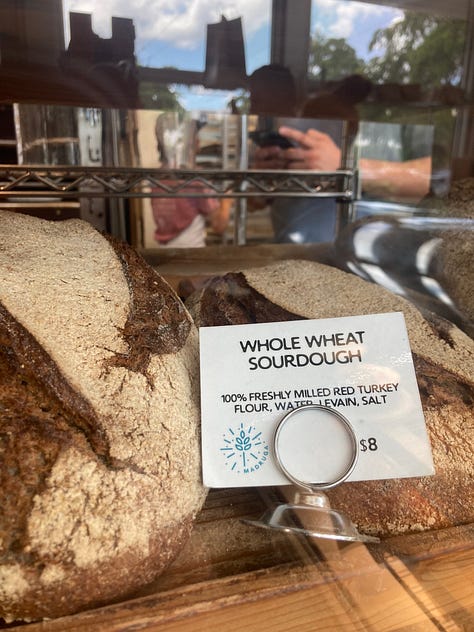
The next day, Jen took me and Grace Garay (Nomad Bakehouse!) to Madruga Bakery, a fresh milling bakery, and I was completely wowed. Everything was terrific and the place was bustling. At the talk, we’d discussed whether the public needs convincing to try the kind of baking we were promoting. A whole lot of bread, pastries and lunches moved through the bakery in the couple of hours we were there. Fresh flour and good baking sell themselves!
Now I am home and we celebrated my mother in law’s 88th birthday! I made a shortcake recipe that included cooked egg yolks with the cream and butter – extraordinary idea, and pretty tasty. Thanks again to Ellen Gray for leading me into cardamon and orange with rhubarb. The blueberry-rhubarb sauce I made was a real winner. I hope you have shortcakes and birthdays, and fresh flour in your future.
Yours, Amy

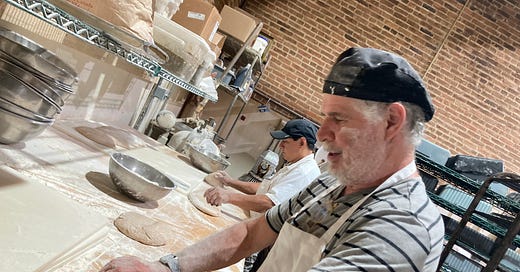




I'm late in replying, but this was a very enjoyable read, and my mouth watered as I imagined all the delicious baked goods described. And your mother-in-law looks darling!
I hear you about sourcing flour! I do try to seek out organic hard and soft wheat kernels, which I grind into flour with my Vitamix. The only negative is the awful noise created by the grinding!
Thanks, Amy, for the Miami recap. 🍞🥖🌴